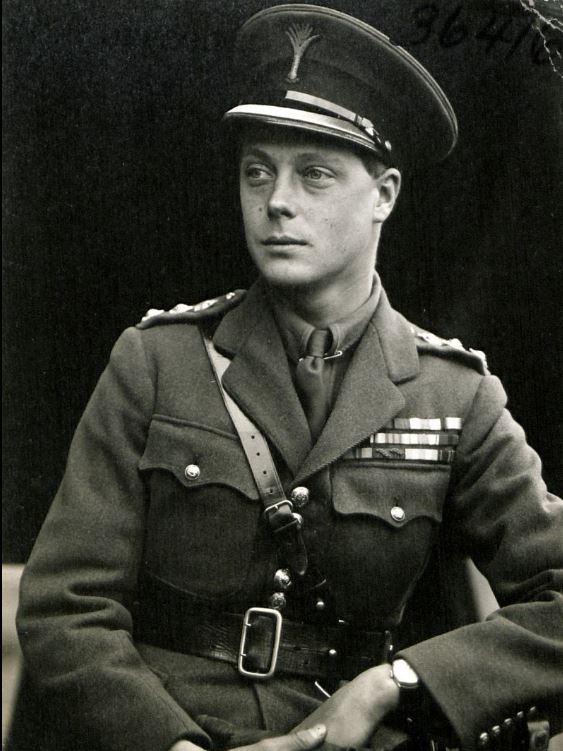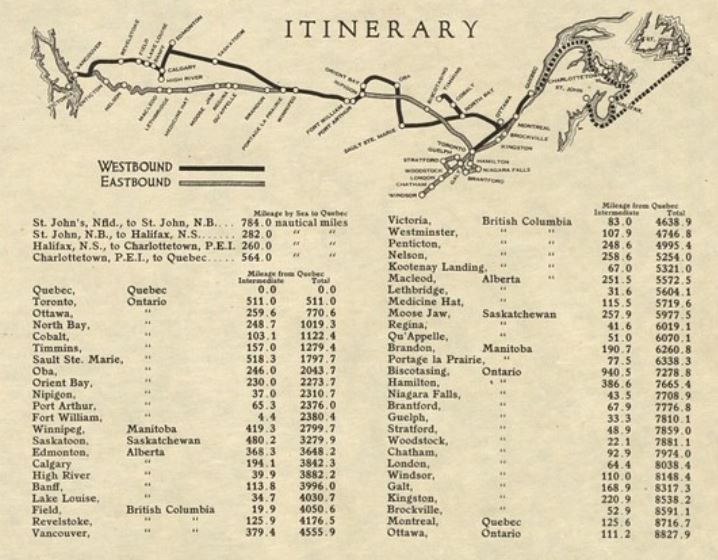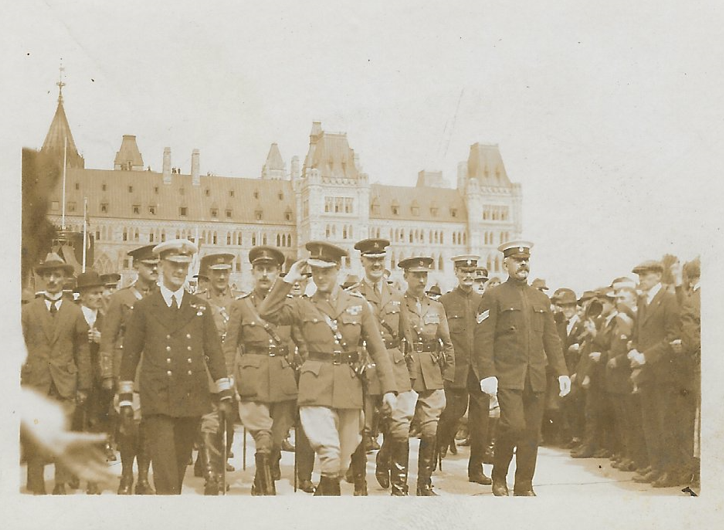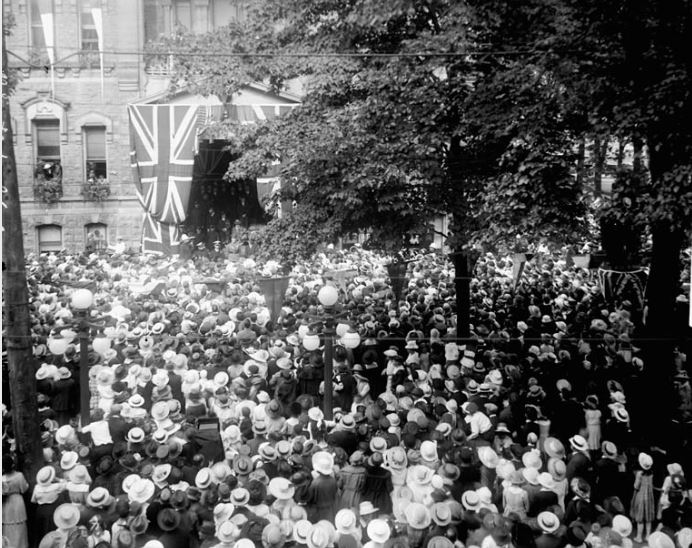28 August 1919
It was August 1919. Less than nine months had passed since the guns fell silent in France and Belgium, and scarcely two months had elapsed from the signing of the Treaty of Versailles that officially ended the Great War. While everybody was elated that the fighting was finally over, and their boys back home, even the victors in this brutal conflict were traumatized. Although Canada had been largely spared the property destruction caused by the war, close to 500,000 men had served in the trenches, on the sea and in the air. More than 60,000 never came home. Tens of thousands more bore the scars of wounds, both physical and mental. It was a rare Canadian family that had not lost a loved one or friend. To make matters worse, the economy was in a shambles. Inflation was high and rising, the consequences of massive wartime spending. Unemployment too was on the rise as servicemen were de-mobilized with few jobs to go to as factories slowed production as government orders for munitions and other war-related supplies dried up.
But spirits were lifted by a Royal Visit by Edward, the Prince of Wales, the oldest son of King George V. The prince had served during the Great War in France, and was widely known as the soldier-prince. Although he had volunteered for active service in 1914, he was not permitted in the front lines owing to his position as heir to the throne. Joining the Grenadier Guards, he became a staff officer to Sir John French, commander of the British Expeditionary Force in France. He also visited troops from the Dominions, including Canada. For a time, he was attached to the staff of Sir Arthur Currie, commander of the Canadian Corps. Young, handsome and debonair, the prince was extremely popular.
The Royal Tour began in St. John’s, Newfoundland, then a separate Dominion from Canada. Prince Edward arrived on 12 August 1919 aboard the battle cruiser, HMS Renown, which was accompanied by the light cruiser HMS Dragon. After an enthusiastic welcome in St. John’s, he went by sea, first to Saint John, New Brunswick, then Halifax, Nova Scotia, and finally Charlottetown, Prince Edward Island, before docking at Quebec City. It was here that he met the Royal Train that would be his home over the next two months, travelling close to 9,000 miles across the Dominion and back. The special CPR train consisted of two baggage cars, the Chinook (a sleeping car), the Canada (a sleeping car), the Carnaven (sic), a dining car, the Chester, the Chromarty, and the Killarney. Royal standards flew from the train’s engine.
Wherever the prince stopped, he was greeted with wild acclaim. This included his stops in Quebec. Decades before the Quiet Revolution, Quebeckers were staunchly pro-monarchy. From Quebec City, Prince Edward travelled to Toronto, where among other things, he attended the Canadian National Exhibition and was greeted by a crowd estimated at 350,000-400,000 strong. From Toronto, he travelled to Ottawa, arriving at the Central Station at 11:00am on Thursday, 28 August 1919. With his train running a bit early, there was an impromptu 30-minute stop at Manotick Station. There, the prince took a stroll through the countryside, stopping to talk to local farmers. He accepted a gift of some apples from a little girl.
The Ottawa Journal said that the prince’s arrival in the capital was met with the “wildest enthusiasm and happiness.” In just a few minutes, Prince Edward “had charmed Ottawa with his happy smile and pleasant manner.”
The city was elaborately decorated with flags and bunting. The Château Laurier Hotel was adorned with three electric signs, one saying “Welcome,” another “Bienvenue,” and the third portraying the three ostrich plume insignia of the Prince of Wales. The Rideau Club, located immediately across from Parliament Hill, bore a large electric sign of the prince’s crest. Union Jacks lined Wellington Street and covered the Langevin Block. Parliament Hill was also bedecked with flags and heraldic shields attached to white posts. The entrance way into the new Centre Block where the cornerstone of the new clocktower would shortly be laid by the prince was draped with dark blue and golden cloths. A canvas-roofed platform, erected at the top of the front steps, was covered with red, white and blue bunting, flags and garlands of cedars. The night before the prince’s arrival in Ottawa, searchlights played over the still unfinished Centre Block.
Immediately prior to the prince’s arrival, streetcar service along Bank and Sussex Streets was suspended. Vehicular traffic was also banned from the processional route. However, before the streets were cleared, disaster almost struck when baskets of tomatoes fell off the back of a truck on Connaught Square leaving a squished red mess on the road. Fortunately, everything was cleaned up in time.
As the Royal Train pulled into the station, the first blast of a 21-gun salute rang out from Cartier Square. On the platform to greet the Prince of Wales were Sir Robert Borden and his Cabinet, Sir Arthur Currie, now the inspector general of Canada’s armed forces, Admirals Halsey and Kingsmill, and Mayor Harold Fisher. The first cheers came from a group of railway workers standing at the end of the platform. A group of newspapermen, forgetting that they were now civilians, snapped to attention with their hats in hand. The prince smiled, saluted them and then moved to inspect the guard of honour, stopping to talk to those with service ribbons. The band of the Governor General’s Foot Guards played the National Anthem.
The crowds in front of the train station surged when they got a glimpse of the prince dressed in the uniform of a colonel of the Welsh Guards. Cheering men and women rushed through the ropes and the mounted police to surround the royal carriage. Anxious officials reportedly relaxed when they saw the prince waiving, saluting and smiling. The Ottawa Journal said that “the very air seemed to pulse and tremble with terrific vibrations of sound” coming from the shouting, and cheering crowds.
Slowly, the carriage made its way to Parliament Hill where 20,000 people were assembled. At the main gates, a guard of honour comprising of members of the Great War Veterans’ Association held the cheering hordes back. In command of the contingent was Lt.-Colonel R. de Salaberry, a descendent of the great Charles-Michel de Salaberry who defeated invading American troops in 1813 at the Battle of Châteauguay.
Accompanied by Mayor Fisher, the prince walked up the steps to the platform erected in front of the new Centre Block. Lining those steps were men, wives, and mothers who lost sons and husbands in the war. At the top of the steps on the flag-bedecked podium, Sir Robert Borden, the Prime Minister, met the prince and officially welcomed him to Canada. After the customary speeches, the prince inspected 1,000 boy scouts and girl guides dressed in their full regalia, as well as members of the Army and Navy Veterans’ Association, including a number of ex-soldiers in wheelchairs.
That afternoon at 4:00pm, there was a garden party at Rideau Hall hosted by the Duke and Duchess of Devonshire. In ninety minutes, the prince shook hands with more than 2,000 guests. One was that of an elderly woman, Mrs Henry McLeod (née Murney), who had danced with his grandfather, then Prince of Wales and later King Edward VII, when he visited Ottawa in 1860 to lay the cornerstone of the old Centre Block that was destroyed by fire in 1916. The prince’s day ended with a dinner at the Country Club on the Aylmer Road.
Exhausted from days of nonstop “meeting and greeting”, the prince cancelled most of the events scheduled for the Friday and the following weekend, including a trip to view the construction on Parliament Hill, a visit to the Mint and a trip north to Lac Blue Sea in the Gatineau Hills. However, his “quiet” Friday still included an official luncheon at the Château Laurier hosted by Sir Robert Borden. Addressing guests, the prince talked about Canadian achievements during the Great War, both at the front and at home, underscoring the heroism of Canadian soldiers. He also thanked Canadian women, calling their achievements, both overseas and at home, “inestimable.” He mourned the loss of so many gallant men who died for King and Empire. He added that many Canadians had befriended him during the war, and now being finally in Canada he found himself “entirely at home.” “Although not born a Canadian, I have the mind and spirit of a Canadian and aim becoming more of a Canadian every day.” He said he looked upon Canada as a second home and asked for people to look at him “as a Canadian who belongs to the Dominion.”
Directly following the luncheon, he attended a huge reception at City Hall on Elgin Street, open to all as the prince wanted to meet the people who did “the dirty work” during the war. Ottawa residents began to line up two hours before the event to get their chance at meeting the Prince of Wales. At 3pm, attendees began to be ushered into the council chamber where there was a small podium erected. The prince, apologizing for only having two hands, personally greeted 2,500 people in 52 minutes—a rate of 45 persons per minute. Among those shaking his hand was Mrs Alice Woolley of 469 Parkdale who told Prince Edward that he should marry soon and raise more little princes like himself. (Advice he should have taken.) The prince also recognized and paused to chat with Sergeant Scoby, a one-armed veteran, who had served in France as a runner for Sir Arthur Currie.
In total, roughly 25,000 people attended the function. The prince signed the City Hall’s visitors’ book “29-8-19 Edward P.” The pen and blotting paper he used disappeared as mementos of the event.
The weekend passed quietly—sort of—with the prince playing 36 holes of golf at the Royal Ottawa Golf Club, with lunch at the Country Club on the Saturday and divine services at St. Bartholomew’s Church on the Sunday, followed by visits to Lady Borden and the recently widowed Lady Laurier. That night, the prince also paid an incognito visit to Parliament Hill to view the illuminations. He was accompanied by John Pearson, the architect of the new Centre Block.
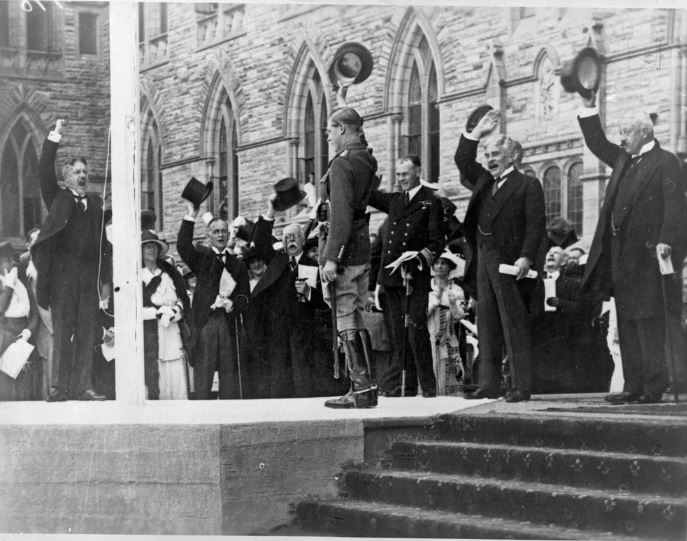
On Monday, Labour Day, the Prince of Wales officially laid the cornerstone of the Victory Tower (later known as the Peace Tower) of the new Centre Block with the full pomp and pageantry expected of such an event. (The cornerstone to the building proper had been re-laid by his great uncle, the Duke of Connaught, in 1916 when work commenced on reconstructing the new Centre Block.) Inside the cornerstone was placed a parchment scroll outlining the history of the building, as well as a prayer thanking God for peace after the long devastating war, a list of attendees and the day’s program, a set of current Canadian coins, local newspapers and other memorabilia. On the outside of the cornerstone was the following inscription:
BY EDWARD PRINCE OF WALES
THIS STONE WAS LAID
SEPT. IST
IN THIS YEAR OF VICTORY
FINIS CORONAT OPVS
The inscription was written in the form of a chronogram with each underlined letter representing a Roman numeral which when added together made 1919. (The Latin inscription means “The end crowns the work.”)
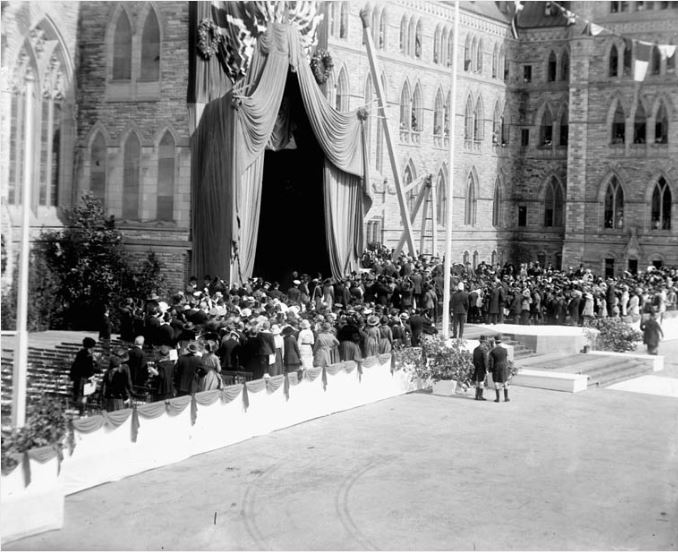
After the ceremony, Prince Edward visited Hull’s City Hall to deafening cheers, and participated in yet another reception, shaking hands with more than 500 people. He also stopped at the new club house of the Great War Veterans’ Association in the city.
The prince departed the Capital on the following day for Smiths Falls for a round of golf at the Dixie golf course before resuming his cross-country tour which was to take him to British Columbia and back.
The Prince of Wales made another five-day stop in Ottawa at the end of his Canadian tour. On 6 November 1919, he was back for a gala charity ball at the Château Laurier in support of the May Court Club. He, along with the governor general and his wife, arrived at the hotel at 10pm to be received by the president of the Club, Miss Sarah Sparks. Supper was held at the Tudor Room at midnight.
The next day, he conferred a knighthood—the Order of St. Michael and St. George—his first ever, on General Morrison at Rideau Hall. Morrison was the last Canadian to be gazetted to a knighthood following the Nickle Resolution over the granting of titles to Canadians. That night, the Duke and Duchess of Devonshire held a “small” dance for two hundred guests in the prince’s honour. He attended yet another dinner-dance at the Country Club on the Saturday after paying an informal visit to the G.W.V.A.’s Ottawa club house. Nursing sisters and members of the Volunteer Aid Detachment (V.A.D.) were also in attendance. There was no handshaking as the prince’s hand was virtually crippled from meeting so many people.
On Sunday, the prince’s last full day in Ottawa, he unveiled the magnificent memorial window, commissioned by the Duke and Duchess of Connaught in honour of Rideau Hall staff who died in the Great War. Afterwards, he walked to MacKay Presbyterian Church to unveil two memorial tablets—one to honour the nineteen members of the church who fell in the Great War and the second to commemorate all of the 140 congregation members who served in the conflict.
The next morning, the Prince of Wales boarded a special train for Washington D.C. to meet President Wilson followed by a stop in New York before heading home.
Prince Edward was to make many further trips to Canada, both formal and informal—his avowed love of the country was not just diplomatic words. In 1919, he purchased the E.P. (Edward Prince) Ranch at High River in the Alberta foothills where he bred livestock imported from his farms in the Duchy of Cornwall. He owned the 100-acre ranch until 1962.
The much loved and admired Prince of Wales was to severely blot his copybook when he took up with the twice-divorced Wallis Simpson during the early1930s. On 11 December 1936, after only ten months on the throne, he abdicated as King Edward VIII so he could marry the woman he loved.
Sources:
Canada’s Historic Places, 2024. E. P. Ranch.
Library and Archives Canada Blog, 2013. Britain’s Future King – A Silent Film of the Visit of Edward, Prince of Wales, to Canada in 1919 – Now on YouTube, 11 September.
Toronto Star, 1919. “History Repeats Itself At St. John, N.B. After 59 Years, 14 August.
Ottawa Citizen, 1919. “Prince of Wales Arrives In Capital At 11 A.M. Today,” 28 August.
——————, 1919. “Prince Meets Thousands At Popular Reception,” 30 August.
——————, 1919. “Prince Passed Quiet Week-End In Capital – Golfed At Royal Ottawa Club Saturday And Attended Divine Service Sunday A.M.” 1 September.
——————, 1919. “Ottawa Bids Soldier-Prince Rousing ‘Au Revoir’, ” 2 September.
——————, 1919. “Hull Throngs Greet Prince With Loyalty,” 2 September.
——————, 1919. “Prince Is Given Warm Greeting In Metropolis,” 3 September.
——————, 1919. “Ottawa Greet Prince On His Return Visit,” 6 November.
——————, 1919. “Prince Attends Brillant Ball For Benefit The May Court Club At the Chateau,” 7 November.
——————, 1919. “Prince To Leave Ottawa At 4 In Afternoon,” 10 November.
——————, 1919. “The Prince Bestows His First Knighthood Upon Gen. Morrison At Rideau Hall,” 7 November.
——————, 1919. “Unveiling Of Memorial Window At St. Bartholomew’s Church And OF Two Tablets at MacKay,” 10 November.
Ottawa Journal, 1919. “Prince’s Programme,” 28 August.
——————-, 1919. “Manotick Girl Gives H.R.H. Some Apples,” 28 August.
——————-, 1919. “A Rousing Welcome For Future King,” 28 August.
——————-, 1919. “Spoke With Sincerity That Carried Message Right To Hearts Of The People Assembled,” 28 August.
——————–, 1919. “Incidents Of A Great Morning In The History Of The Capital,” 28 August.
——————–, 1919. “Scouts And Guides Were Out In Force,” 28 August.
——————–, 1919. “Hundreds Of Ottawa Citizens Shake Hand Of Heir To Throne,” 29 August.
——————–, 1919. “Prince Gratified At Ottawa’s Great Welcome,” 29 August.
——————–, 1919. “Big Crowd To Greet Prince At City Hall,” 29 August.
——————–, 1919. “A Very Real Joy To Be In Canada H.R.H. Declares,” 29 August.
——————–, 1919. “‘Prince Charmant’ Is Guest Of Honor At May Court Club Ball Last Night,” 7 November.
——————-, 1919. “No Handshakes At Prince’s Reception,” 8 November.
Waterloo Regional Record, 1919. “Renown Near Port,” 11 August.
